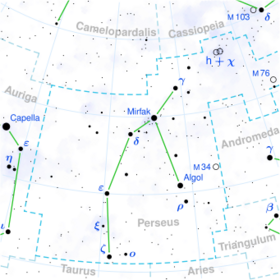Astronomy:16 Persei
| Observation data Equinox J2000.0]] (ICRS) | |
|---|---|
| Constellation | Perseus |
| Right ascension | 02h 50m 35.05979s[1] |
| Declination | 38° 19′ 07.1080″[1] |
| Apparent magnitude (V) | 4.22[2] |
| Characteristics | |
| Spectral type | F2III[3] |
| U−B color index | +0.08[4] |
| B−V color index | +0.34[4] |
| Variable type | δ Sct(?)[5][6] |
| Astrometry | |
| Radial velocity (Rv) | +14.00[7] km/s |
| Proper motion (μ) | RA: +195.77[1] mas/yr Dec.: −109.98[1] mas/yr |
| Parallax (π) | 27.01 ± 0.19[1] mas |
| Distance | 120.8 ± 0.8 ly (37.0 ± 0.3 pc) |
| Absolute magnitude (MV) | 1.38[2] |
| Details | |
| Mass | 1.80[8] M☉ |
| Radius | 3.2[9] R☉ |
| Luminosity | 23.36[2] L☉ |
| Surface gravity (log g) | 3.72[10] cgs |
| Temperature | 7,004[10] K |
| Metallicity [Fe/H] | −0.04[2] dex |
| Rotational velocity (v sin i) | 149[3] km/s |
| Age | 1.44[8] Gyr |
| Other designations | |
| Database references | |
| SIMBAD | data |
16 Persei is a single,[12] suspected variable star[6] in the northern constellation of Perseus, located approximately 121 light years away based on parallax.[1] It is visible to the naked eye as a yellow-white hued star with an apparent visual magnitude of 4.22.[2] This object is moving further from the Earth with a heliocentric radial velocity of +14 km/s.[7] It displays a relatively high proper motion, traversing the celestial sphere at the rate of 0.224″ per year.[13]
Based upon a stellar classification of F2 III,[3] this matches an aging giant star that has exhausted the hydrogen at its core and is evolving away from the main sequence. It is a possible pulsating Delta Scuti variable, although there is some uncertainty about this classification.[6] However, Kunzli and North (1998) found no variation.[14] The star is 1.44[8] billion years old with 1.8[8] times the mass of the Sun and 3.2[9] times the Sun's radius. It shows a high rotation rate with a projected rotational velocity of 149 km/s,[3] which is causing an equatorial bulge that is an estimated 24% larger than the polar radius.[15] 16 Persei is radiating 23[2] times the Sun's luminosity from its photosphere at an effective temperature of 7,004 K.[10]
It has two reported visual companions: B, with magnitude 12.8 and separation 76.7", and C, with magnitude 10.43 and separation 234".[16]
References
- ↑ 1.0 1.1 1.2 1.3 1.4 1.5 Van Leeuwen, F. (2007). "Validation of the new Hipparcos reduction". Astronomy and Astrophysics 474 (2): 653–664. doi:10.1051/0004-6361:20078357. Bibcode: 2007A&A...474..653V. Vizier catalog entry
- ↑ 2.0 2.1 2.2 2.3 2.4 2.5 Anderson, E.; Francis, Ch. (2012). "XHIP: An extended hipparcos compilation". Astronomy Letters 38 (5): 331. doi:10.1134/S1063773712050015. Bibcode: 2012AstL...38..331A. Vizier catalog entry
- ↑ 3.0 3.1 3.2 3.3 Hoffleit, D.; Warren, W. H. (1995). "VizieR Online Data Catalog: Bright Star Catalogue, 5th Revised Ed. (Hoffleit+, 1991)". VizieR On-line Data Catalog: V/50. Originally Published in: 1964BS....C......0H 5050. Bibcode: 1995yCat.5050....0H.
- ↑ 4.0 4.1 Mallama, A. (2014). "Sloan Magnitudes for the Brightest Stars". The Journal of the American Association of Variable Star Observers 42: 443. Bibcode: 2014JAVSO..42..443M.Vizier catalog entry
- ↑ "NSV 956". The International Variable Star Index. AAVSO – American Association of Variable Star Observers. https://www.aavso.org/vsx/index.php?view=detail.top&oid=39580.
- ↑ 6.0 6.1 6.2 Samus, N. N. et al. (2017). "General Catalogue of Variable Stars". Astronomy Reports. 5.1 61 (1): 80–88. doi:10.1134/S1063772917010085. Bibcode: 2017ARep...61...80S.
- ↑ 7.0 7.1 Wilson, R. E. (1953). General Catalogue of Stellar Radial Velocities. Carnegie Institution for Science. Bibcode: 1953GCRV..C......0W.
- ↑ 8.0 8.1 8.2 8.3 Luck, R. Earle (2015), "Abundances in the Local Region. I. G and K Giants", Astronomical Journal 150 (3): 88, doi:10.1088/0004-6256/150/3/88, Bibcode: 2015AJ....150...88L.
- ↑ 9.0 9.1 Allende Prieto, C.; Lambert, D. L. (1999). "Fundamental parameters of nearby stars from the comparison with evolutionary calculations: Masses, radii and effective temperatures". Astronomy and Astrophysics 352: 555–562. Bibcode: 1999A&A...352..555A. Vizier catalog entry
- ↑ 10.0 10.1 10.2 David, Trevor J.; Hillenbrand, Lynne A. (2015). "The Ages of Early-Type Stars: Strömgren Photometric Methods Calibrated, Validated, Tested, and Applied to Hosts and Prospective Hosts of Directly Imaged Exoplanets". The Astrophysical Journal 804 (2): 146. doi:10.1088/0004-637X/804/2/146. Bibcode: 2015ApJ...804..146D. Vizier catalog entry
- ↑ "16 Per". SIMBAD. Centre de données astronomiques de Strasbourg. http://simbad.u-strasbg.fr/simbad/sim-basic?Ident=16+Per.
- ↑ Eggleton, P. P.; Tokovinin, A. A. (September 2008). "A catalogue of multiplicity among bright stellar systems". Monthly Notices of the Royal Astronomical Society 389 (2): 869–879. doi:10.1111/j.1365-2966.2008.13596.x. Bibcode: 2008MNRAS.389..869E.
- ↑ Lépine, Sébastien; Shara, Michael M. (March 2005), "A Catalog of Northern Stars with Annual Proper Motions Larger than 0.15" (LSPM-NORTH Catalog)", The Astronomical Journal 129 (3): 1483–1522, doi:10.1086/427854, Bibcode: 2005AJ....129.1483L.
- ↑ Kunzli, M.; North, P. (January 1998). "Are metallic A-F giants evolved AM stars? Rotation and rate of binaries among giant F stars". Astronomy and Astrophysics Supplement 127 (2): 277–294. doi:10.1051/aas:1998350. Bibcode: 1998A&AS..127..277K.
- ↑ van Belle, Gerard T. (March 2012), "Interferometric observations of rapidly rotating stars", The Astronomy and Astrophysics Review 20 (1): 51, doi:10.1007/s00159-012-0051-2, Bibcode: 2012A&ARv..20...51V.
- ↑ Mason, Brian D.; Wycoff, Gary L.; Hartkopf, William I.; Douglass, Geoffrey G.; Worley, Charles E. (2001). "The 2001 US Naval Observatory Double Star CD-ROM. I. The Washington Double Star Catalog". The Astronomical Journal 122 (6): 3466. doi:10.1086/323920. Bibcode: 2001AJ....122.3466M. Vizier catalog entry
 |


